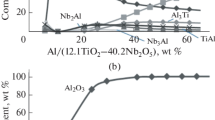Abstract
Experiments were carried out to remove arsenic from antimony trioxide by two techniques: first, by selectively volatilizing the more volatile arsenic trioxide from a mixed oxide sample; and, second, by selectively condensing the less volatile antimony tetroxide at high temperatures, leaving arsenic trioxide to condense out at a lower temperature. Thermodynamic analysis of the As-Sb-O system indicated that if arsenic and antimony oxides behave like pure solid phases, then there is no limitation to producing pure antimony oxide by these proposed techniques. The selective volatilization experiments were carried out at 379 °C to 587 °C, using both nitrogen and air as carrier gases and an industrial antimony trioxide fume containing 13.8 wt pct As. The results showed it is difficult to achieve an arsenic content below 5.0 wt pct using either air or nitrogen, and formation of solid solutions between arsenic and antimony trioxides appears to be the main barrier to the removal of arsenic. Selective condensation experiments were carried out in which a mixed oxide vapor was progressively cooled through a series of condensers over a controlled temperature profile. Injection of oxygen into the vapor improved separation, and antimony tetroxide containing as low as 0.23 wt pct As was obtained. The recovery of antimony tetroxide in the experiments seems to have been limited by kinetic factors, and the results sug-gest that high conversions to antimony tetroxide are likely to be achieved only in antimony-rich vapors.
Similar content being viewed by others
References
C.L. Read:Ind. Eng. Chem. 1928, vol. 20 (1), pp. 97–100.
B.W. Lightfoot: Ausmelt Pty. Ltd, Victoria, Australia, private communication, 1992.
R.A. Daniele: inArsenic and Mercury: Workshop on Removal, Recovery, Treatment, and Disposal, Proc. Conf. United States Environmental Protection Agency. Alexandria, VA, 1992.
G.A. Brooks: Ph.D. Thesis, The University of Melbourne, Melbourne, Australia, 1993.
J.H. Norman and H.G. Staley:J. Chem. Phys., 1964, vol. 41 (5), pp. 1503–04.
J.E. Mauser:Metall. Trans. B, 1982, vol. 13B, pp. 511–13.
J.P. Hager and T. Li:Reinhardt Schuhman Int. Symp., TMS, Warrendale, PA, 1987, pp. 845–68.
G.A. Brooks and W.J. Rankin:Metall. Mater. Trans. B, 1994, vol. 25B, pp. 865–71.
D.L. Kaiser: Master's Thesis, Colorado School of Mines, Golden, CO, 1980.
C.W. Bale and G. Eriksson:Can. Metall, Q., 1990, vol. 29, pp. 105–32.
Author information
Authors and Affiliations
Additional information
Formerly with the G.K. Williams Cooperative Research Centre for Extractive Metallurgy.
Rights and permissions
About this article
Cite this article
Brooks, G.A., Rankin, W.J. & Gray, N.B. Thermal separation of arsenic and antimony oxides. Metall Mater Trans B 25, 873–884 (1994). https://doi.org/10.1007/BF02662769
Received:
Issue Date:
DOI: https://doi.org/10.1007/BF02662769




